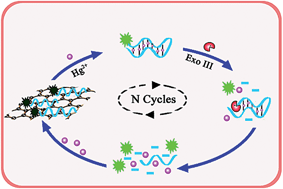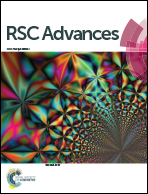Graphene nanosensor for highly sensitive fluorescence turn-on detection of Hg2+ based on target recycling amplification
Abstract
The development of sensitive and selective methods for the monitoring of toxic heavy metal ions is highly demanded because of their threats to the environment and human health. Based on a new exonuclease III (Exo III)-assisted target recycling amplification strategy, a highly sensitive fluorescence turn-on nanosensor for Hg2+ detection using graphene oxide (GO)-quenched, thymine-rich FAM-ssDNA nanoprobes is developed. The target Hg2+ ions bind and fold the GO-adsorbed FAM-ssDNA into duplex structures through the formation of T–Hg2+–T base pairing, leading to the release of the FAM-ssDNA from the surface of GO and recovery of the fluorescent signal. Besides, the released and folded duplex can be digested by Exo III to liberate the bound Hg2+ ions, which can again associate with the GO-quenched FAM-ssDNA nanoprobes and trigger the target recycling process to cause cyclic cleavage of the GO-adsorbed FAM-ssDNA. This target recycling process therefore results in the release of numerous FAM labels back into the solution and significantly amplified fluorescent signal is obtained for highly sensitive detection of Hg2+ down to the sub-nanomolar level. The developed nanosensor also exhibits high selectivity against non-specific ions and can be potentially employed to monitor other toxic heavy metal ions at ultralow levels.


 Please wait while we load your content...
Please wait while we load your content...